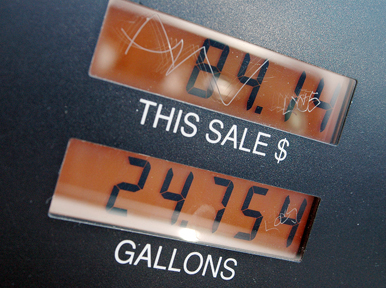
Local commuters don’t like it, but are resigned to dealing with
the high price of gas
Commuter Marc Hopkins navigated his massive Dodge Durango up to
a gas pump at Gilroy’s Amerigas station, gliding in
”
on fumes,
”
he said.
The station offered a below-average California price for gas in
the Garlic Capital this week
– a wallet-busting $3.29 a gallon.
Still, the Gilroy resident whose job takes him on sales calls
from San Francisco to Monterey said he’s not angry about the
ever-rising cost of petrol. Hopkins said the pinch should come as
no surprise to anyone, and it’s the price we have to pay for being
a nation of gas gluttons.
Local commuters don’t like it, but are resigned to dealing with the high price of gas
Commuter Marc Hopkins navigated his massive Dodge Durango up to a gas pump at Gilroy’s Amerigas station, gliding in “on fumes,” he said.
The station offered a below-average California price for gas in the Garlic Capital this week – a wallet-busting $3.29 a gallon.
Still, the Gilroy resident whose job takes him on sales calls from San Francisco to Monterey said he’s not angry about the ever-rising cost of petrol. Hopkins said the pinch should come as no surprise to anyone, and it’s the price we have to pay for being a nation of gas gluttons.
“I hear people complain,” Hopkins said, as the pump racked up $85 to fill his tank. “They say ‘It’s going to get higher.’ Well, duh!”
Hopkins’ accepting attitude toward soaring gas prices throughout the nation is one that seems to be shared by many motorists throughout the region, who were interviewed by The Pinnacle as they filled their tanks this week at local stations on a hot afternoon.
The resigned attitude comes as no surprise to Sean Comey, spokesman for the Automobile Association of America, Northern California region.
“People are complaining a lot less than they did a couple of years ago,” Comey said. “I think consumers are becoming numb, that they feel these are circumstances beyond their control – which I find troubling because that’s not the case.”
Comey explained that when public leaders don’t hear any outrage from their constituents over gas prices, they become “inert.” Once there is public outrage and the media bursts with news reports on the issue, that’s when politicians threaten the big oil companies with taxes and new policies. Prices, Comey said, “coincidentally drop,” the crisis leaves the front pages, “then we move on to something else and the cycle repeats itself.”
“There are legitimate market forces driving it up,” he added. “But there’s a psychology to it.”
Some drivers even think it’s a good thing to pay such exorbitant gas prices.
“I think gas prices should be high, actually,” said Chris Paduan of San Jose, on his way home from attending an arts and music festival in Indio. At least it’s not as bad here as it is in the city of Baker, he added, where gas goes for $3.75 a gallon.
As he filled his tank at the Gilroy Shell station near the outlet malls off 10th Street, Paduan explained his reasoning: the higher the gas, the more incentive to use alternative transportation, such as hybrid vehicles.
Fellow motorist Hopkins agreed that the only solution to the nation’s gas crisis is to get off the oil teat.
“It’s not going to go down until we go alternative,” Hopkins said. “We’re handcuffed to our cars to a degree.”
But neither Paduan nor Hopkins was driving the alternatives. With average gas prices in the state hovering between three and four bucks a gallon, it’s apparently not enough to drive consumers to the break point of investing in a hybrid or other fuel-saving alternative.
Comey said there are less drastic ways to save fuel, such as keeping tires inflated properly and scheduling routine maintenance. [See sidebar.]
“We did a poll last year, and a significant amount said they need to fill their car no matter what,” Comey said. “The trouble is when gas prices peak out we see a little decrease in consumption but not much.”
It could be that many motorists, including Hopkins, have the luxury of working for companies that pay for the gas in their tank. But as the pinch hits company bottom lines, the trickle-down economics that ensue could become a worse nightmare for commuters and workers, as lay-offs and inflated costs of living – of everything – could go on an upswing. [See related story, page A1].
It’s an effect already felt by Rachel Cabrera of Fresno who, with her sister and seven children, stopped at the Gilroy Shell on a family daytrip to Santa Cruz. As her sister managed pit stops for the children in a line outside the bathrooms, Cabrera rearranged the back trunk of one of two cars. It was loaded with a chest full of ice and food.
“As you can see, we pack our own stuff now,” Cabrera said. “For the last three weeks it [the cost of gasoline] has been going up. I’ve been watching it move.”
One feeling that seemed to be universal among the motorists interviewed was a disdain and resentment for Big Oil.
One driver, blowing through Gilroy on his way to Sacramento, said the gas crunch has curbed his lifestyle and pocketbook, and he rhetorically asks why the Bush Administration hasn’t taken action.
“I don’t go out anymore,” said German Yives, as he filled his Pontiac Grand Am. “I’m waiting for Mr. Bush or Congress to do something. It’s causing inflation for everything.”
In Hollister, the cost of gas is not quite as high as it is in the South Valley. Last week, Ranch Gas (Coast Oil) sold regular for $3.14, while neighboring stations on San Benito/San Felipe were hovering between $3.10 and $3.15.
Hollister’s prices weren’t any easier to swallow for Vincent Misenti of Sacramento as he filled his tank at Ranch Gas before making his way to Monterey.
“The oil companies are making more money than any other industry in the world,” he said. “So I think the price gouging is going to go on.”









